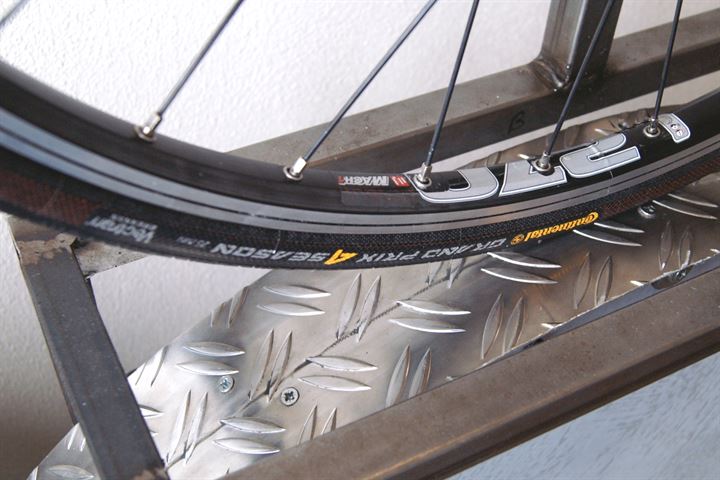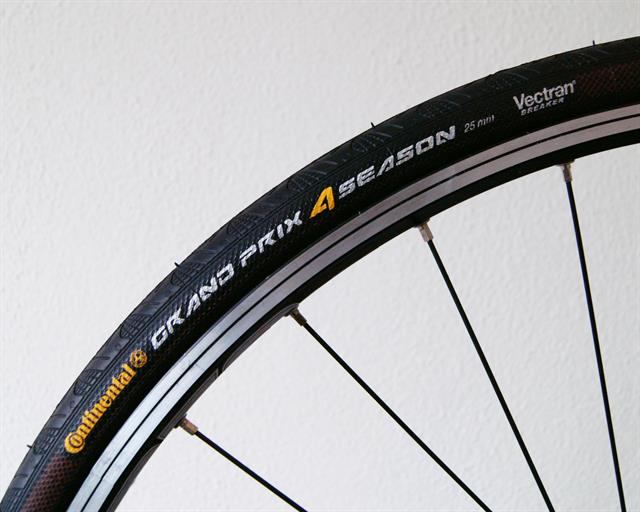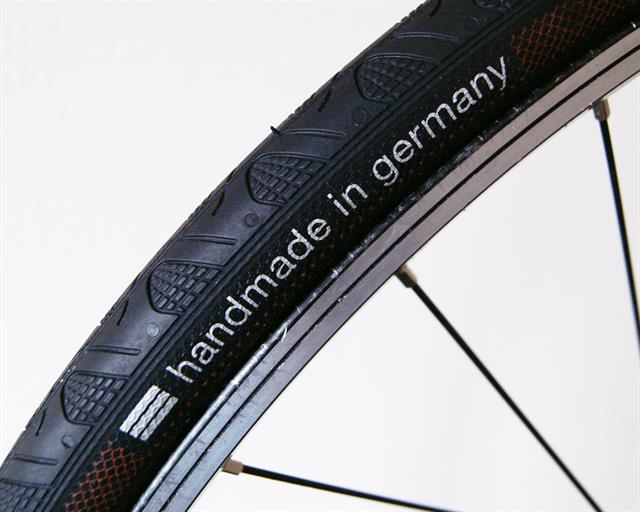Road Bike Tire Test: Continental Grand Prix 4 Season 2015 25
Contents and Test Summary
- Introduction
- Manufacturer Specifications
- Size, Weight, Thickness
- Rolling Resistance: 17.2 Watts
- Puncture Resistance: 80 Points
- Static Wet Grip: No Data
- Conclusion: 4.0 / 5 Recommended
- Comments
- Continental Grand Prix 4 Season 2015 25
(100% is best)

NOTE: We have a test available of a newer version of this tire: Continental Grand Prix 4 Season 2022
The Continental Grand Prix 4 Season is a top of the line, all-season road bike tire. This tire is a close cousin of the Grand Prix 4000S II (read review) as both tires use a 3/330 TPI casing and are handmade in Germany.
Ad Buy Continental Grand Prix 4 Season 2015 at Amazon.com
To make the 4 Season an all-season tire, Continental designed this tire with a double layer of Vectran breaker under the tread, an extra layer of DuraSkin from bead to bead, and a silica compound optimized for cold and wet weather.
When going for a tire like the Grand Prix 4 Season, rolling resistance is probably not the most important point to consider. Puncture resistance and grip on wet and cold surfaces will be the main selling point. I do think it's interesting to know the rolling resistance of the 4 Season, especially at lower air pressures.
Most Continental high-end tires use the Black Chili compound which always performs excellent in the rolling resistance tests. The 4 Season doesn't use the Black Chili compound but instead uses a different "Max Grip" compound. This compound is a softer silica compound which provides more grip in all-weather conditions. The compound change will probably make the biggest difference during the rolling resistance tests.
Being able to compare all data side by side with the GP4000S II data might make the decision to switch between summer/winter tires a bit easier. Jump to the comparison section of our website to compare all data of the GP 4 season and GP 4000S II side by side.
Manufacturer Specifications
| Manufacturer Specifications | |
|---|---|
| Brand | Continental |
| Model | Grand Prix 4 Season 2015 |
| Year | 2015 |
| Tire Type | Tubetype (clincher) |
| Supplied By | Bought in store |
| New or Used | New |
| Mileage | 0 km |
| Price Range | High |
| Buy At | Ad Amazon.com |
| Manufacturer part number | 0100175 |
| TPI | 3/330 |
| Compound | Max Grip Silica |
| Bead | Folding |
| ETRTO | 25-622 |
| Size Inch | 28" |
| Specified Width (mm) | 25 |
| Specified Weight | 240 grams |
| Max Air Pressure (psi) | 120 |
| Made In | Members Only |
| Available Sizes |
23-622 (700x23C) 25-622 (700x25C) 28-622 (700x28C) 32-622 (700x32C) |
Continental Grand Prix 4 Season 2015 25 Test Results

Size, Weight, and Thickness Measurements
| Size, Weight and Thickness Measurements | |
|---|---|
| Specified Weight | 240 grams |
| Measured Weight | 215 grams |
| System Adjusted Weight (tire + inner tube (100 gr) |
315 grams |
| Measured Width | 27 mm (un-round) |
| Measured Height | 24 mm (un-round) |
| Total Tire Thickness Center | 2.7 mm |
| Total Tire Thickness Sidewall | Members Only |
| Unmounted Casing Width | No Data |
| Unmounted Tread Width | No Data |
| Tread Cover (Tread / Casing Ratio) | No Data |
| All size measurements are taken at an air pressure of 100 psi / 6.9 bars on a 17.8 mm inner width rim. | |
Weight. While the specified weight of the 700 x 25C 4 Season is 240 grams, the tire used for this test weighed in at a very low 215 grams. 215 grams is even less than the specified weight of the GP4000S II.
Size. Measured width and height on a 17C rim is 27 mm and 24 mm respectively.
Tire Thickness. With a weight this low, there can't be a lot of rubber on the tire. After measuring the total thickness of the tire at the center of the tread, it turns out the 4 Season is thinner than the GP4000S II (2.7 mm Vs 2.9 mm). The sidewalls are a bit thicker at 0.7 mm Vs 0.55 for the GP4000S II.
Rolling Resistance Test Results
| Rolling Resistance Test Results | |
|---|---|
| Inner Tube | Conti Race28 (100gr butyl) |
| Measured Width | 27 mm (un-round) |
| Rolling Resistance Real tire width in mm: 22-24 = 132 psi/9.1 bar 25-27 = 120 psi/8.3 bar 28-29 = 108 psi/7.4 barUltra High Air Pressure (120 psi / 8.3 bar) |
17.2 Watts CRR: 0.00516 |
| Rolling Resistance Real tire width in mm: 22-24 = 110 psi/7.6bar 25-27 = 100 psi/6.9 bar 28-29 = 90 psi/6.2 barExtra High Air Pressure (100 psi / 6.9 bar) |
18.1 Watts CRR: 0.00543 |
| Rolling Resistance Real tire width in mm: 22-24 = 88 psi/6.1 bar 25-27 = 80 psi/5.5 bar 28-29 = 72 psi/5.0 barHigh Air Pressure (80 psi / 5.5 bar) |
Members Only |
| Rolling Resistance Real tire width in mm: 22-24 = 66 psi/4.6 bar 25-27 = 60 psi/4.1 bar 28-29 = 54 psi/3.7 barMedium Air Pressure (60 psi / 4.1 bar) |
Members Only |
| The Road Bike section is a multi tire size section, air pressures have been adjusted to the measured casing width. All numbers are for a single tire at a speed of 29 km/h / 18 mph and a load of 42.5 kg / 94 lbs. Use the formula: RR (Watts) = CRR * speed (m/s) * load (N) to calculate rolling resistance at a given speed and load. |
|
At an air pressure of 120 psi / 8.3 bars, rolling resistance is 17.2 watts (GP4000S II = 12.2 wats). Dropping air pressure to 100 psi / 6.9 bars results in a rolling resistance of 18.2 watts (GP4000S = 12.9 watts). At a comfortable air pressure of 80 psi / 5.5 bars, rolling resistance is 19.8 watts (GP4000S II = 13.7 watts).
Rolling resistance is decent for an all-weather tire but it's obvious rolling resistance isn't as low as most other summer tires. The differences also get bigger when dropping air pressure to a more comfortable air pressure range (80 - 100 psi).
Puncture Resistance Test Results

| Puncture Resistance Test Results (higher is better) | |
|---|---|
| Total Puncture Score Tread | 80 Points |
| Total Puncture Score Sidewall | Members Only |
| Tread Puncture Force Sharp Needle | 17 Points |
| Tread Puncture Force Blunt Needle | No Data |
| Tread Total Tire Thickness | 2.7 mm |
| Sidewall Puncture Force Sharp Needle | Members Only |
| Sidewall Puncture Force Blunt Needle | No Data |
| Sidewall Total Tire Thickness | Members Only |
One of the main selling points of the 4 Season is its claimed high puncture resistance. With a score of 17 points in the tread puncture resistance test, the 4 Season performs excellent. 17 points is a much better score than the 11 points the GP4000S II scored.
In the sidewall puncture test, the 4 season scores 7 points which is 2 points more than the 5 points the GP4000S II scored.
A more comparable tire is the Continental Gatorskin (read review) which scored 18 points in the puncture resistance tread test and 7 points in the sidewall test. The Gatorskin does have an even higher rolling resistance of 19.3 watts at 120 psi / 8.3 bars.
Static Grip Test Results
NOTE: Grip test data is only available on tires tested after November 2018. You can find more information about our grip test here: Introducing Grip Testing
| Static Grip Test Results | |
|---|---|
| Wet Grip Average | No Data |
| Wet Grip Center | No Data |
| Wet Grip Edge | No Data |
| Grip in points = coefficient of friction * 100 Road bike grip test rim width = 19.0 mm |
|
Conclusion
- Continental Grand Prix 4 Season 2015 25
(100% is best)
As expected, rolling resistance is higher than pure summer tires like the GP4000S II. For a pair of tires, cycling at a speed of 18 mph / 29 km/h, an extra 10 to 12 watts of power input is required to obtain the same speed. In return for this extra effort, you get a stronger tire and increased grip in cold and wet conditions. When taking both into consideration, the Grand Prix 4 Season is a great tire.
I would have given the Grand Prix 4 Season a 5-star rating if it had just a little lower rolling resistance. I was hoping it to come in closer to the 16 watts range. Still, it is a great tire with a high puncture resistance and low rolling resistance. I'm interested in your opinion about it's wet and cold weather qualities as well; let me know in the comments.
Ad Buy Continental Grand Prix 4 Season 2015 at Amazon.com
RATING:
4.0
/ 5
TEST VERDICT:
Recommended
